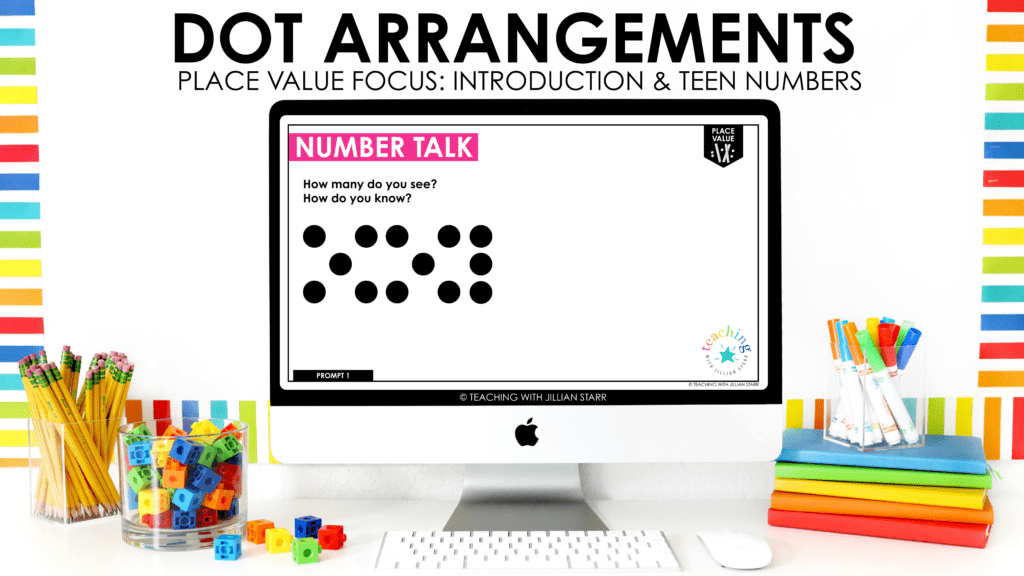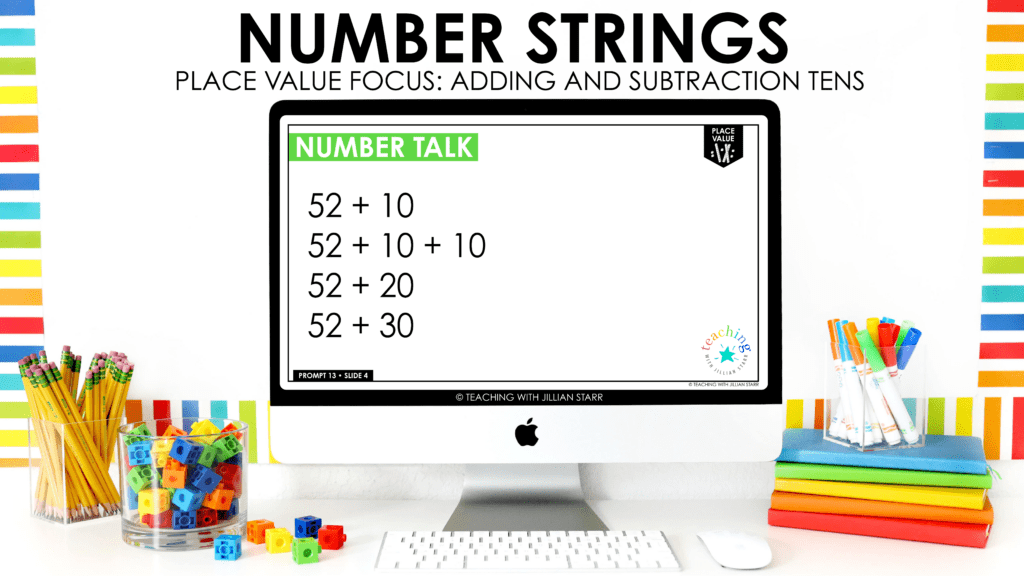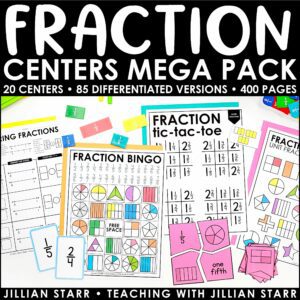
We’ve been focusing on different ways to introduce and teach place value and today I’m sharing one of my favorite activities EVER! Number Talks are a powerful strategy for teaching place value and, similar to the other strategies we’ve covered, they are also very easy to implement, saving those valuable prep minutes for everything else on your to-do list.
One of my favorite things about number talks? While they are short (10 – 15 min), and easy to use, this mental math activity packs a serious punch. Number talks can be included as a lesson warm-up, as part of a lesson, or even as a stand-alone activity.
Teachers select problems for students to solve that help make the connection between their conceptual understanding, in this case of place value, and mental math fluency. Not only do students solve these problems, but they also share their strategies, opening the door for peer-led learning. When combined, all of the components of number talks, create a powerful routine that we can use to effectively teach place value.
Why Number Talks?
While the phrase “Common Core Standards” is something I’ve heard way too many times in my life, the Math Practice Standards that are found there and in many individual state standards are certainly full of practices that we want our students to exhibit (and, if your district is similar to where I have worked, a required part of report cards).
Consider these practices:
- Making sense of problems and persevering in solving them
- Reasoning abstractly and quantitatively
- Attending to precision
- Looking for and making use of structure
- Constructing arguments and critiquing the reasoning of others
Number Talks are one of those versatile activities that provide students with the opportunity to hone all of these practices.
Thinking Outside the Algorithm
Additionally, Number Talks emphasize student thinking and ideas over algorithms or procedures that may have been learned. They put students’ thinking at the forefront and support the idea that there is more than one way to solve a problem. Students will share their different ways of solving the same problem, allowing students to learn from one another thus building a stronger mathematical community in the classroom.
And, wait! There’s even more. Number Talks, of course, help students to learn the actual math at hand. Math discourse is a great way to support the use of precise mathematical language, such as “tens place” or “addend.” They also build connections between conceptual understanding, procedural fluency, and mental math strategies. By solving problems using mental math, students grow in their ability to flexibly compose and decompose numbers.
Perhaps the best argument for using number talks in your math block? Students are highly engaged when participating in them. Similar to other strategies like Notice and Wonder or Counting Collections, Number Talks provide students with multiple entry points, making this activity accessible to all learners. Students enjoy seeing their thinking in writing. The sense of ownership is powerful for students and helps them build their identities as mathematicians. What could possibly be better than that?
Getting Started with Number Talks
You know I wouldn’t recommend an activity and leave you hanging without ideas for getting started right away!
Number Talks can be a single prompt or a string of equations that build upon each other. When planning your Number Talk, you need to decide if you’ll be supporting students with their place value understanding or pushing them towards a new place value understanding. Both play an important role and your goals will likely change depending on students’ needs on any given day.
In my previous post, I shared lists of prompts that you could use immediately. Today, I’m taking it even further! If you’re ready to bring number talks into your classroom today, I have 20 ready-to-use prompts that you can grab for FREE right here:

FREE Number Talks
First grade teachers, access 20 FREE Number Talk Prompts to enhance your place value unit and get your students engaged in conversation.
Ready to read on? Here is how I use them:
Number Talks: Beginning Prompts
The first Number Talk slide features 13 dots. However, they are strategically placed to encourage students to see two groups of 5 and 3 more so that they are able to recognize 10 and 3 more. This prompt continues the work of understanding teen numbers as ten and some more.


When displaying this slide, I ask students, “How many do you see? How do you know?” Like other math routines, I accept all students’ answers and explanations, even incorrect ones. There are an additional three prompts that build on this theme using dot images.
Number Talks: Visual Introduction to Number Strings
After students get adjusted to the routine of number talks and can discuss dot arrangements, we start to introduce the concept of number strings. Number strings are an intentional series of related prompts used to guide students to a specific strategy.
In this free resource, the number strings prompt is made up of three to four slides. These help students build understanding as they progress through each slide, going through the discussion routine one at a time.


While number strings typically use written numerals, our next six prompts introduce the concept visually. We want to use visuals that reinforce groups of ten, so in this resource, you’ll find images of ten frames, Unifix Cube trains of ten, and rekenreks to help get students started.
Number Talks: Number Strings
Later in the set of slides is a short string of expressions beginning with 52 + 10. I ask students to determine the sum mentally and after allowing students time to think, I have multiple students share the sum and their strategy for arriving at their answer. I make sure to record the strategies each student shares, regardless if they are correct.


The remaining expressions in this string are 52 + 10 + 10, 52 + 20, and 52 + 30. Similar to the first expression, I ask students to solve them and then have students share their answers and thinking. If no one has brought it up, I make sure to ask students how they can use the previous expression(s) to help them solve the later ones.


For example, students may share that they know 52 + 20 is 72 because they know because 20 is the same as 10 + 10. Since 52 + 10 + 10 was 72, then 52 + 20 must also be 72.
Make sure to grab your free pack of 20 Number Talks! Some prompts can be used as individual slides while other prompts have a few slides to use in one session. ALL of them are labeled and easy to use. I know you’ll love them!







FREE Number Talks
First grade teachers, access 20 FREE Number Talk Prompts to enhance your place value unit and get your students engaged in conversation.
Best Tips for a Successful Number Talk
Let’s end with easy moves that you can make to make your Number Talk even more successful.
Lean Into Wait Time
Give lots of wait time and I mean a. lot. I usually wait until all or nearly all of my students are showing me that they are ready to share before I begin calling on students. Sometimes students begin to get impatient waiting but I want to ensure that all students get a chance to think about the prompt because once the discussion begins, students shift from thinking about their own ideas to thinking about others’ ideas.
Consider Your Discussion Model
Rather than raising hands, I have students use hand signals during Number Talks. Some students will immediately raise their hands when asked a question and that can be intimidating for other students. Because I want all of my students to feel comfortable participating in Number Talks, I prefer to have students show a more discrete thumbs up when they are ready to share.
While they are waiting for the discussion, I’ll ask students to think about a second way that they could answer the question. If they are able to think of another way to solve the problem, they’ll hold out their pointer finger. They’ll continue adding fingers to show me how many ways they have thought about the problem. These hand signals allow all students to think about the prompt while also making sure the students who were ready early on continue pushing their thinking.
Write Down…EVERYTHING!
As I mentioned earlier, I record all answers and strategies that students share, whether they are correct or incorrect. Instead of immediately dismissing incorrect answers or strategies, I ask students to share their thinking in detail. Often students will discover their own errors or a student who shares later will correct another student’s strategy. I also use specific questions to get students to push their thinking when necessary.
Use Prompts to Guide Discussion
Some of my favorite prompts to use?
- Tell me why you …
- How do you know that your answer is correct?
- Why does your strategy work?
- Can you explain that another way?
- Do you agree/disagree with what someone else shared?
Take things a step further and encourage students to make connections between prompts. Ask students to share how their thinking from the previous day helped them with the current prompt. Doing this will help students see all of this work as connected rather than as separate, isolated activities.
Make Teacher Wait Time Your Friend
Trust me, I know that this is harder than it sounds! I get excited about what students are saying and I really have to hold my tongue to allow them to finish without me adding my own comments or questions. However, allowing students to speak freely and truly listening to them, gives students true ownership over their ideas and strategies which is really powerful.







FREE Number Talks
First grade teachers, access 20 FREE Number Talk Prompts to enhance your place value unit and get your students engaged in conversation.
Don’t Try to Do Everything At Once
Encourage students to use precise language but don’t make it the emphasis of the Number Talk. We want students to be thinking about the math concepts without stressing about using the correct words. However, when a student uses an imprecise word like “thing,” I often will rephrase what the student said using the math vocabulary.
I hope you feel as excited about number talks as I do. I can’t wait to hear how you use this powerful tool in your own classroom! We’ll continue our month-long deep dive into place value next week!










Can you send me the second grade number talk slides? These ideas are all great.
I’ve been using the notice and wonder. Collections. And counting activities for warm ups and math team talks.
Thank you.
Hi Sue Anne! The second grade set is not available yet. We are working through a series of Place Value articles for first grade, and this series of prompts made sense in the context. We’re looking forward to creating new sets soon.